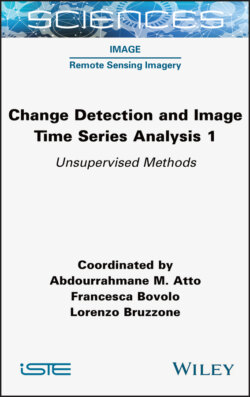Читать книгу Change Detection and Image Time-Series Analysis 1 - Группа авторов - Страница 17
1.3. Unsupervised multiclass change detection approaches based on modeling spectral–spatial information 1.3.1. Sequential spectral change vector analysis (S2CVA)
ОглавлениеHere, we first recall a popular state-of-the-art unsupervised multiclass CD method, S2CVA. The two proposed approaches are designed based on it. However, it is important to note that the S2CVA that is pixel-wise only relies on the analysis of spectral information. Originally, from the standard C2VA (Bovolo et al. 2012), S2CVA was specially proposed for multiclass CD in bitemporal hyperspectral images according to a hierarchical analysis. It allows the visualization and detection of multiple changes by considering all spectral channels, without neglecting any band. A compressed 2D polar domain is built based on the construction of two change variables (Liu et al. 2015), i.e. magnitude ρ and direction θ. More particularly, the magnitude ρ is the Euclidean compression of SCVs. It measures the spectral brightness of changes. The direction θ is built based on the spectral angle distance (SAD) (Keshava 2004), which points out different changes with respect to the variances in spectral response for a given pixel. However, note that the “from–to” class transition information is not explained due to the unsupervised nature of S2CVA. More specifically, the change variables ρ and θ are defined as:
[1.1]
[1.2]
where is the b-th (b=1,...,B) component of the differencing (SCVs) image XD, which was calculated on the co-registered images X1 and X2, and B is the number of image bands (i.e. the dimensionality of SCVs). rb is the b-th component of an adaptive reference vector r. In the standard C2VA, r is defined as a unit constant vector (Bovolo et al. 2012). In S2CVA, it is improved as the first eigenvector of the covariance matrix A of XD (Liu et al. 2015):
[1.3]
where [XD] is the expectation of XD. The eigen-decomposition of A can be represented as:
[1.4]
where W is a diagonal matrix with eigenvalues being sorted in a descending order (i.e. λ1 < λ2 < ...λB) in the diagonal, and V is the matrix of eigenvectors (i.e. V = [v1, v2, v3, ..., vB]). The reference vector r is defined as the first eigenvector v1 corresponding to the largest eigenvalue λ1, i.e. r = v1. Note that this results in an improved change representation by projecting the SCVs into a reference direction that maximizes the variance of the measurement, while preserving the discriminative information of different changes.
Figure 1.2. 2D polar change representation domain in the C2VA method
Then a 2D compressed polar domain D is defined based on ρ and θ:
[1.5]
where ρmax is the maximum value of ρ. A semicircle scattergram (see Figure 1.2) is used for visualizing multiple changes in D. Regions of the semicircle SCn (which represents the unchanged pixels) and the semiannulus SAc (which represents the changed pixels) are mathematically defined as:
[1.6]
[1.7]
Under the assumption that X1 and X2 are radiometrically and geometrically corrected, in the 2D polar domain, the unchanged SCVs result in low magnitude values close to zero and are thus distributed within SCn, whereas the changed SCVs are represented in SAc having higher magnitudes. Different spectral behaviors of the SCVs reflected on the direction variable, hence leading to the representation of multiclass changes in each sector of SAc. The considered multiclass CD problem is solved by defining a threshold Tρ along the magnitude ρ to separate the unchanged and changed SCVs (i.e. associated with SCn and SAc, respectively), and to separate multiple changes (C1,...,CK) along the direction θ by setting multiple thresholds Tθ,k (k=1,..., K-1) in SAc. Note that a hierarchical analysis is implemented to discover and detect all possible changes (both strong and subtle changes) in hyperspectral images due to complex change representations in the high dimensionality of hyperspectral images. However, fewer levels may be obtained when only a few spectral bands are considered, as in the multispectral case.
